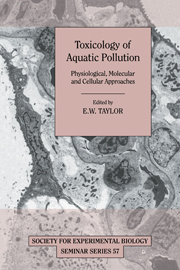Book contents
- Frontmatter
- Contents
- List of contributors
- Preface
- Water chemistry at the gill surfaces of fish and the uptake of xenobiotics
- Bioaccumulation of waterborne 1,2,4,5-tetrachlorobenzene in tissues of rainbow trout
- Dietary exposure to toxic metals in fish
- The physiology and toxicology of zinc in fish
- Lethal and sub-lethal effects of copper upon fish: a role for ammonia toxicity?
- The physiological status of brown trout exposed to aluminium in acidic soft waters
- Physiological and metabolic costs of acclimation to chronic sub-lethal acid and aluminium exposure in rainbow trout
- Physiological effects of nitrite in teleosts and crustaceans
- Metallothioneins in fish: induction and use in environmental monitoring
- Oestrogenic substances in the aquatic environment and their potential impact on animals, particularly fish
- Effect of genetic toxicants in aquatic organisms
- In vitro toxicology of aquatic pollutants: use of cultured fish cells
- Principles governing the use of cytochrome P4501A1 measurement as a pollution monitoring tool in the aquatic environment
- Index
Oestrogenic substances in the aquatic environment and their potential impact on animals, particularly fish
Published online by Cambridge University Press: 20 May 2010
- Frontmatter
- Contents
- List of contributors
- Preface
- Water chemistry at the gill surfaces of fish and the uptake of xenobiotics
- Bioaccumulation of waterborne 1,2,4,5-tetrachlorobenzene in tissues of rainbow trout
- Dietary exposure to toxic metals in fish
- The physiology and toxicology of zinc in fish
- Lethal and sub-lethal effects of copper upon fish: a role for ammonia toxicity?
- The physiological status of brown trout exposed to aluminium in acidic soft waters
- Physiological and metabolic costs of acclimation to chronic sub-lethal acid and aluminium exposure in rainbow trout
- Physiological effects of nitrite in teleosts and crustaceans
- Metallothioneins in fish: induction and use in environmental monitoring
- Oestrogenic substances in the aquatic environment and their potential impact on animals, particularly fish
- Effect of genetic toxicants in aquatic organisms
- In vitro toxicology of aquatic pollutants: use of cultured fish cells
- Principles governing the use of cytochrome P4501A1 measurement as a pollution monitoring tool in the aquatic environment
- Index
Summary
Introduction
In this review we summarize what is known presently about which oestrogenic substances are present in the aquatic environment, at what concentrations they are present, and then discuss what effects these oestrogenic substances might have on aquatic organisms. By ‘oestrogenic substances’ we mean chemicals that have been shown to mimic the physiological effects of true oestrogens such as 17β-oestradiol (the major physiologically active oestrogen in all classes of vertebrates). Oestradiol is quite a small molecule; its molecular weight is 272 and it is composed of four aromatic rings (Fig. 1). Likewise, chemicals which mimic the effects of oestradiol are often small, and their structures are often based around one or more aromatic rings (Fig. 1 for examples). However, not all oestrogenic substances have structures which superficially resemble that of oestradiol; kepone, for example, does not have a structure which would in any way suggest that it might act as an oestrogen (Fig. 1). Because chemicals which do not resemble oestradiol can function as oestrogens, it has not been possible to predict, based on knowledge of their structures, which chemicals might be oestrogenic; hence, the oestrogenic activity of chemicals has usually been discovered only when effects are noted, by which time the chemical might be in widespread use (DDT provides a good example here). Further, it is suggested from recent findings (see later section on oestrogenic effects on aquatic organisms) that there are chemicals already in widespread use, and therefore present in most (if not all) environments, which are not recognized presently to be oestrogenic, but which might yet turn out to be so.
- Type
- Chapter
- Information
- Toxicology of Aquatic PollutionPhysiological, Molecular and Cellular Approaches, pp. 205 - 224Publisher: Cambridge University PressPrint publication year: 1996
- 24
- Cited by



